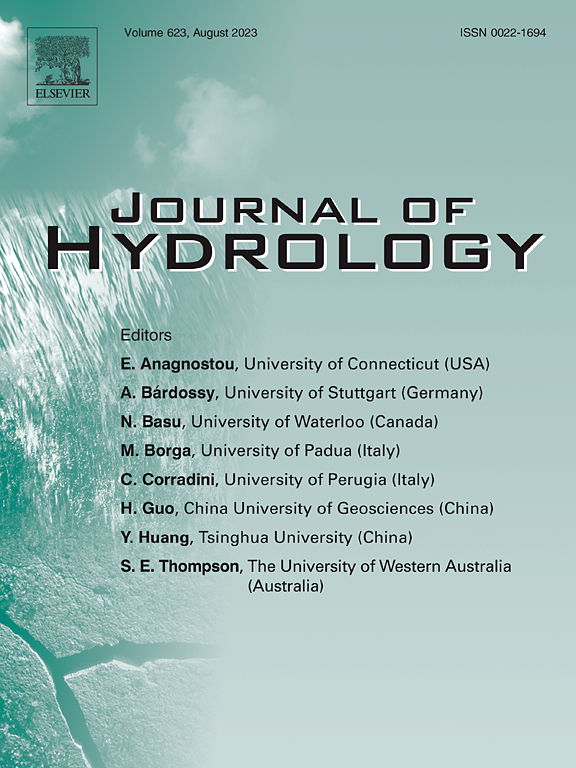维也纳浅层含水层的补给和氧化还原过程影响着城市地下水的质量
IF 6.3
1区 地球科学
Q1 ENGINEERING, CIVIL
引用次数: 0
摘要
城市地下水的质量受到水文地质、人为活动和基础设施影响的各种过程的复杂相互作用。了解这些因素及其时空动态对城市水资源的可持续管理至关重要。迄今为止,通常缺乏包含足够关键参数和适当空间分辨率的城市含水层数据集。在此,我们提出了一种高空间分辨率的多示踪方法来评估城市浅层地下水质量的控制因素。在维也纳温暖(2021年秋季)和寒冷(2022年春季)的条件下,从144至154口地下水井中采集了水样。利用主要离子、营养物质、重金属、水稳定同位素和硝酸盐同位素、废水指示化合物和温室气体等综合参数分析了空间和季节变化。统计分析表明,影响地下水质量的主要过程是补给过程、氧化还原过程和岩水相互作用。综合示踪解释表明,受地表水-地下水相互作用、废水泄漏污染和不同氧化还原过程(如反硝化)影响的区域。进一步的厌氧过程,包括铁和锰还原、硫酸盐还原和甲烷生成,都被证明会影响地下水质量。在城市地下基础设施附近,地下水温度高达27℃,这表明地下建筑和地表密封对浅层地下水起着额外的压力作用。通过高分辨率空间采样,可以绘制城市地下水补给和氧化还原过程的地图,从而更好地了解地下水质量动态,并为制定可持续管理城市水资源的策略提供基础。本文章由计算机程序翻译,如有差异,请以英文原文为准。

Recharge and redox processes drive urban groundwater quality in Vienna’s shallow aquifers
The quality of urban groundwater is subject to a complex interplay of various processes influenced by hydrogeology, anthropogenic activities, and infrastructure. Understanding these factors and their spatial and temporal dynamics is essential for the sustainable management of urban water resources. To date, data sets containing sufficient key parameters and an appropriate spatial resolution have often been lacking for urban aquifers. Here, we present a high-spatial resolution multi-tracer approach to assess the controlling factors of shallow urban groundwater quality. Water samples were collected from 144 to 154 groundwater wells during warm (fall 2021) and cold (spring 2022) conditions in Vienna. A comprehensive set of parameters (major ions, nutrients, heavy metals, water stable isotopes and nitrate isotopes, wastewater indicator compounds and greenhouse gases) was analyzed to evaluate spatial and seasonal variations. Statistical analysis revealed that the dominant processes affecting groundwater quality are recharge, redox processes, and rock-water interactions. A combined tracer interpretation indicated zones influenced by surface water - groundwater interactions, pollution from wastewater leakage, and different redox processes, such as denitrification. Further anaerobic processes, including iron and manganese reduction, sulfate reduction, and methanogenesis, were shown to impact groundwater quality. Groundwater temperatures of up to 27 °C were observed near urban subsurface infrastructure, indicating that subsurface buildings and surface sealing act as additional stressors to shallow groundwater. The presented high-resolution spatial sampling enabled the creation of maps of urban groundwater recharge, redox processes, which provide a better understanding of groundwater quality dynamics and serves as basis for developing strategies to sustainably manage urban water resources.
求助全文
通过发布文献求助,成功后即可免费获取论文全文。
去求助
来源期刊

Journal of Hydrology
地学-地球科学综合
CiteScore
11.00
自引率
12.50%
发文量
1309
审稿时长
7.5 months
期刊介绍:
The Journal of Hydrology publishes original research papers and comprehensive reviews in all the subfields of the hydrological sciences including water based management and policy issues that impact on economics and society. These comprise, but are not limited to the physical, chemical, biogeochemical, stochastic and systems aspects of surface and groundwater hydrology, hydrometeorology and hydrogeology. Relevant topics incorporating the insights and methodologies of disciplines such as climatology, water resource systems, hydraulics, agrohydrology, geomorphology, soil science, instrumentation and remote sensing, civil and environmental engineering are included. Social science perspectives on hydrological problems such as resource and ecological economics, environmental sociology, psychology and behavioural science, management and policy analysis are also invited. Multi-and interdisciplinary analyses of hydrological problems are within scope. The science published in the Journal of Hydrology is relevant to catchment scales rather than exclusively to a local scale or site.
 求助内容:
求助内容: 应助结果提醒方式:
应助结果提醒方式:


